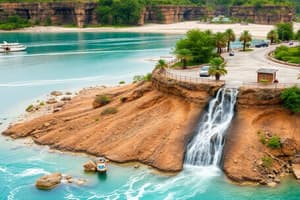Podcast
Questions and Answers
Natural disasters have no significant impact on human mental health.
Natural disasters have no significant impact on human mental health.
False (B)
Tsunamis are caused solely by geological activities like underwater earthquakes.
Tsunamis are caused solely by geological activities like underwater earthquakes.
True (A)
Heatwaves fall under the category of climatological disasters.
Heatwaves fall under the category of climatological disasters.
True (A)
Hurricanes and tornadoes are both types of geological disasters.
Hurricanes and tornadoes are both types of geological disasters.
Epidemics and pandemics are forms of biological disasters.
Epidemics and pandemics are forms of biological disasters.
Displacement of populations can be a consequence of natural disasters.
Displacement of populations can be a consequence of natural disasters.
Soil erosion is an economic impact of natural disasters.
Soil erosion is an economic impact of natural disasters.
Disaster-resistant structures help in the prevention and mitigation of natural disasters.
Disaster-resistant structures help in the prevention and mitigation of natural disasters.
Climate change has no effect on the frequency of natural disasters.
Climate change has no effect on the frequency of natural disasters.
Emergency planning includes creating disaster response plans and evacuation routes.
Emergency planning includes creating disaster response plans and evacuation routes.
Flashcards are hidden until you start studying
Study Notes
Natural Disasters
Definition
- Natural disasters are severe, extreme weather events or geological processes that cause significant damage to life, property, and the environment.
Types of Natural Disasters
-
Geological Disasters
- Earthquakes: Sudden shaking of the ground caused by tectonic movements.
- Volcanic Eruptions: Explosive eruptions from a volcano releasing ash, gas, and lava.
- Tsunamis: Large ocean waves caused by underwater earthquakes or volcanic eruptions.
-
Meteorological Disasters
- Hurricanes/Typhoons: Intense tropical storms with strong winds and heavy rain.
- Tornadoes: Violently rotating columns of air extending from thunderstorms to the ground.
- Floods: Overflow of water onto normally dry land, often due to heavy rainfall or dam failure.
-
Climatological Disasters
- Droughts: Extended periods of deficient rainfall resulting in water shortages.
- Heatwaves: Prolonged periods of excessively hot weather.
- Wildfires: Uncontrolled fires in forested or grassland areas, often exacerbated by dry conditions.
-
Biological Disasters
- Epidemics/Pandemics: Widespread outbreaks of infectious diseases.
- Invasive Species: Non-native organisms that disrupt local ecosystems and economies.
Impact of Natural Disasters
-
Human Impact
- Loss of life and injuries
- Displacement of populations
- Mental health issues (trauma, stress)
-
Economic Impact
- Damage to infrastructure (homes, roads, utilities)
- Disruption of local economies and livelihoods
- Increased reconstruction and recovery costs
-
Environmental Impact
- Habitat destruction
- Soil erosion and degradation
- Changes to land use and biodiversity loss
Preparedness and Response
- Risk Assessment: Identifying vulnerable areas and populations.
- Emergency Planning: Creating disaster response plans and evacuation routes.
- Education and Training: Educating communities about disaster risks and response procedures.
- Recovery Efforts: Providing aid and support post-disaster to rebuild communities.
Prevention and Mitigation Strategies
- Infrastructure Development: Building disaster-resistant structures and systems.
- Environmental Management: Responsible land use planning and natural resource management.
- Early Warning Systems: Implementing technology for timely alerts about impending disasters.
Global Perspective
- Climate Change: Increasing frequency and intensity of certain natural disasters linked to global warming.
- International Aid: Global cooperation in disaster response and recovery efforts.
Natural Disasters
- Natural disasters are severe events caused by nature, impacting life, infrastructure, and the environment.
Types of Natural Disasters
- Geological Disasters: Result from earth's movement, include earthquakes, volcanic eruptions, and tsunamis.
- Meteorological Disasters: Caused by weather conditions, including hurricanes/typhoons, tornadoes, and floods.
- Climatological Disasters: Result from long-term weather patterns, including droughts, heatwaves, and wildfires.
- Biological Disasters: Caused by living organisms, including epidemics/pandemics and invasive species.
Impact of Natural Disasters
- Human Impact: Loss of life, injuries, displacement, and mental health issues like trauma and stress.
- Economic Impact: Damage to infrastructure, disruption of local economies, and increased reconstruction costs.
- Environmental Impact: Habitat destruction, soil erosion, and changes to land use, leading to biodiversity loss.
Preparedness and Response
- Risk Assessment: Identifying vulnerable areas and populations to target prevention and response efforts.
- Emergency Planning: Creating disaster response plans and evacuation routes for timely and effective action.
- Education and Training: Educating communities about disaster risks and response procedures, promoting proactive actions.
- Recovery Efforts: Providing aid and support post-disaster to rebuild communities and address immediate needs.
Prevention and Mitigation Strategies
- Infrastructure Development: Building disaster-resistant structures and systems to minimize damage from future events.
- Environmental Management: Responsible land use planning and natural resource management, reducing vulnerability to disasters.
- Early Warning Systems: Implementing technology for timely alerts about impending disasters to allow for evacuation and preparedness.
Global Perspective
- Climate Change: Increasing frequency and intensity of certain natural disasters are linked to global warming, highlighting a growing concern.
- International Aid: Global cooperation in disaster response and recovery efforts is crucial, emphasizing the importance of international collaboration.
Studying That Suits You
Use AI to generate personalized quizzes and flashcards to suit your learning preferences.




